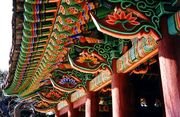
In ancient Chinese texts, Korea is referred to as "Rivers and Mountains Embroidered in Gold" (錦繡江山) and "Eastern Nation of Decorum" (東方禮儀之國). During the 7th and 8th centuries, land and sea trading networks connected Korea to Arabia. As early as 845, Arab traders mentioned Korea saying, "Over the sea beyond China lies a mountainous country called 'Silla', rich in gold. Muslims who arrive there by accident are so attracted by its character that they stay there forever and do not want to leave."
Korean festivities often showcase vibrant colors, which have been attributed to Mongolian influences: bright red, yellow, and green often mark traditional Korean motifs. These bright colors are sometimes seen in the traditional dress known as hanbok.
Literature
Korean literature is traditionally divided into two categories. The literature written until the end of the Joseon Dynasty is called "Classical". The literary production posterior to this era is called named "New" or "Modern" literature. Unlike their predecessors, writers of modern literature are largely influenced by Western authors.
Korea's classical literature came into being in the context of local beliefs, and the in the wake of Taoism, Confucianism and Buddhism, with a dominance of the latter. Recorded in Chinese characters, literature of the "Classical" Age produced innovative poetic forms such as hyangga.




No comments:
Post a Comment